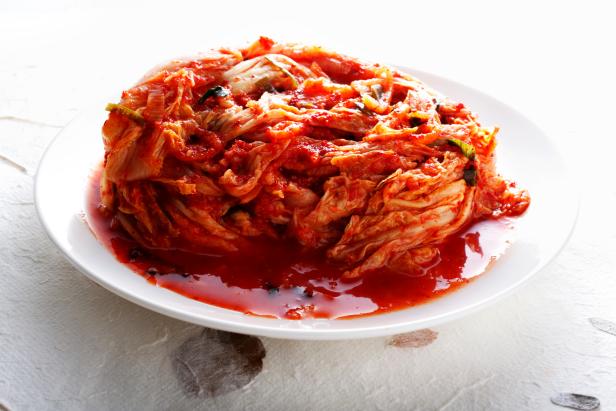
By Layla Khoury-Hanold for Food Network Kitchen
Layla Khoury-Hanold is a contributor at Food Network.
Perhaps you’ve sampled kimchi at a Korean restaurant or have heard it touted as a fermented super food chockful of probiotics. But there’s a lot more about kimchi to unpack, and that’s why we turned to Pascale Yamashita, a recipe developer, food stylist, food photographer and avid food lover who was raised in a Korean household and now resides in Japan.
Kimchi is a traditional Korean dish made with salted and fermented vegetables. Baechu kimchi is the most iconic and is made with napa cabbage, salt, garlic, ginger, scallions, fish sauce and gochugaru (Korean chili flake), which gives it its trademark spiciness and red color. “What makes kimchi special is that the salted/pickled vegetable is marinated, then fermented,” Yamashita says. “Going through these three stages gives kimchi its distinctive taste.”
‘Kimchi’ is used to refer to all vegetable kimchis. “The number would be equal to the number of varieties of Korean vegetables, including mountain vegetables available in Korea,” Yamashita says. Some examples of other vegetable kimchi include kkakdugi (radish), oi sobagi (cucumber) and Kkaennip kimchi (perilla leaf). Not all kimchi is made with gochugaru, Yamashita says, and therefore not red in color. One category is mul kimchi, or water kimchi, which includes dongchimi, a cold, brothy radish kimchi that Yamashita says koreans enjoy for its refreshing taste and as a palate cleanser after a meat-heavy meal.
Kimchi was first made to preserve vegetables for future consumption, especially during colder months when vegetables were scarce. To make enough kimchi to last for at least three months and up to a year, families gathered to have enough labor to process the hundreds of napa cabbages needed to make such quantities. This village-driven tradition of making and sharing kimchi is called kim-jang.
Yamashita visited Korea every year growing up and remembers her grandmother participating in kim-jang with relatives. Once all the ingredients were gathered, the women would sit around to make kimchi, with different groups responsible for each of the steps of the kimchi making process, such as cutting, washing or salting the cabbages. “Imagine women squatting in the backyard around many huge bowls and containers preparing them,” Yamashita says. “It was also an event where people would share, chat and gossip, and often it’s where women first learn how to make kimchi.” At the end of the process, the families gather for a small party to sample the newly made kimchi, before it ferments, a treat that is only enjoyed on that day.
Yamashita says that from the 1970s to the 1990s, white collar workers even received a kim-jang bonus from their companies, a quantity of kimchi that was valued at a couple months’ salary. Today, not as many women stay home to make kimchi, and kimchi is readily available to buy in grocery stores. Yamashita says that some families still participate in kim-jang in the fall and share the yield with family and friends. Kim-jang events and demonstrations are also held at companies and community centers as a means of cultural preservation and education. Kim-jang is also recognized by UNESCO as part of Korea’s Intangible Cultural Heritage.
Overall, kimchi is sour, spicy and savory, but its flavor profile varies depending on the types of vegetables and supplemental ingredients used, as well as the aging period. “Kimchi is usually crunchy but depending on the vegetable it could be otherwise. But it’ll still be flavorful from all the ginger, garlic and scallions, salty from the fish sauce, and tangy from the sugar that turns into lactic acid in the process,” Yamashita says. “Kimchi gets more and more tangy as it ferments.”
Subbing in oysters, anchovy sauce or fermented squid for the fish sauce will alter the umami and saltiness of the final product, and miniscule differences among basic ingredients, such as the coarseness of the salt, different kinds of gochugaru, the water content and sweetness of the cabbage and the flavor of the garlic and ginger also affect how kimchi tastes. “If you are in Korea, check out different areas and you will find one area has spicier or saltier kimchi and a different area has lighter and refreshing kimchi,” Yamashita says. “It is said the more you move to the south, the more the kimchi tends to be spicier. The further north you go, the milder it gets.”
Kimchi recipes vary from household to household, with family recipes reflecting their own taste and ingredient preferences. The basic ingredients for kimchi include gochugaru, garlic, ginger, fish sauce, rice glue, salt and sugar. It often also includes julienned daikon radishes and carrots; sometimes Asian pears or apples are added to the brine for sweetness. Other ingredients can be added or subbed in, such as oysters (although the oysters can break down within the kimchi if kept too long, so it’s best to eat within 2 to 3 weeks), or minari, which would give the kimchi herbaceous flair but could overpower the other ingredients.
Since kimchi is made by lacto-fermentation, just like sauerkraut, yogurt or kefir, it develops probiotics that contribute to a healthy gut microbiome that helps support digestion and immunity, according to Dana Angelo White, MS, RD, ATC., a registered dietitian and owner of Dana White Nutrition, Inc. Furthermore, it contains about 30 calories per 1/2 cup.
Yamashita says: “What lots of Korean mothers tell their children is that this is a vegetable and it’s got all that goodness yogurt has, so it’s a double combo of what your mom wants you to eat.”
“Koreans usually have rice and soup to enjoy with their meal with several side dishes known as banchan, so kimchi helps add some tangy crunch amongst the softer savory banchans. Many enjoy a good bone broth soup and usually people eat this with rice, and kimchi also goes very well with it,” Yamashita says.
Yamashita shares that another popular way of enjoying kimchi is in Ssam, which means ‘to wrap.’ Grilled or boiled meat, usually pork, are wrapped in Korean lettuce or perilla leaves with kimchi, sometimes with Korean fermented soy bean paste, too. Kimchi is often stir-fried in dishes alongside onion, garlic and gochujang. One such dish is dweji-kimchi bokkeum, which literally means stir fried pork and kimchi, and is typically enjoyed with rice. Sour kimchi varieties are typically washed, then chopped and added to stir-fries or Korean kimchi stew/soup, called Kimchi Jjigae. Another classic Korean dish made with kimchi is Kimchi Bibim Guksu (pictured above), a dish of cold noodles that employs kimchi, gochugaru, gochujang and sugar to achieve a spicy-sweet balance.
Kimchi continues to ferment once its opened, so it becomes more pungent and sour as time passes. It may become less appealing to eat if it gets to the point where the vegetables lose their crispness, or the flavor becomes too sour or strong. Yamashita shares that in Korea, some people throw old kimchi away while others appreciate it. “In Korea, you can specifically purchase old kimchi that has been fermented for months. Usually, its deep flavor is enjoyed, or people buy them to use for cooking dishes such as kimchi jjigae (a type of stew) or kimchi fried rice.”
You’ll know it’s time to toss your kimchi when the sour smell turns rancid, if there is an extreme color change, like Napa cabbage kimchi turning from bright red to a brownish, red-orange, or if it develops mold. Yamashita recommends storing your kimchi in the refrigerator to extend its shelf-life, and to always handle kimchi with washed hands and clean utensils (using a contaminated utensil or handling kimchi with unwashed hands can cause mold to grow on kimchi).
Kimchi accompanies nearly every meal in Korea, so it’s worth mastering a few basic recipes. Then experiment with adding kimchi to traditional dishes and creative spins, anywhere that would benefit from a funky, crunchy, umami punch of flavor. Try adding it to a bowl of ramen or rice bowls, or use it to make a condiment, as with this burger-topping kimchi mayo. Yamashita says that younger generations of Korea enjoy kimchi with melted cheese, adding it to fried rice and grilled cheese sandwiches.
All families have their own variation of this iconic kimchi recipe. This one, developed by Jackie Ji Yoon Park for Food Network Kitchen, is based on her grandmother’s recipe. Kimchi is a labor of love but with a little planning and preparation work, you can salt the cabbage and make the dasima anchovy broth and rice glue the day before, then leave the remaining prep for the next day. It’s worth the effort to achieve making a batch of homemade kimchi, in all its pungent, funky, spicy-sour glory.
You can use any type of cucumber here, but Kirby cukes make for an extra crunchy, flavorful condiment. Cucumber kimchi makes a fine accompaniment to Korean BBQ or other grilled proteins, and a fantastic burger topping in place of pickles. And don’t worry about eating them up all at once—they’ll last up to a week in the fridge.
This kimchi is made with perilla leaves, a leafy green herb that’s part of the mint family. This kimchi incorporates a water-based sauce that helps to lightly season the kimchi, while allowing the fresh and herbaceous minty notes of the perilla leaves to shine through.
Although it won’t have the savory depth and acidic tang of a fermented kimchi, this quick kimchi makes flavorful pickled cabbage in a fraction of the time. A spicy, savory paste made with jalapenos, garlic, ginger, sugar, fish sauce and red pepper flakes is used to coat chopped napa cabbage and scallions, then left to marinate in the fridge for at least 4 hours.

